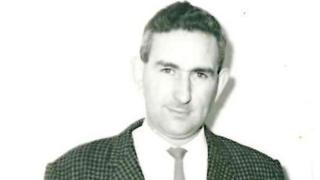[ad_1]

Image copyright
Family picture
Retired police officer Charles Nunn, pictured here as a young man, died in December
The community of Aberfan has paid tribute to a retired police officer for his work during the disaster more than 50 years ago.
Charles Nunn, 85, died in December.
He ran a make-shift mortuary in a chapel in the south Wales village after a slag heap engulfed Pantglas Junior School on 21 October 1966.
Mr Nunn, from Mumbles, Swansea, helped families identify the bodies of 116 children and 28 adults.
“I am still to this day struck by their sheer dignity as they queued in the rain waiting to identify their child,” he told BBC Wales just weeks before his death.
Image copyright
PA
A slag heap engulfed Pantglas Junior School in October 1966
Jeff Edwards MBE, the last surviving child to be rescued from the remains of the school, said: “It was with great sadness that we heard of the passing of Charles Nunn who as a police officer at the time of the Aberfan disaster had the responsibility of identification of bodies and liaising with bereaved families.
“The impact on him like other rescuers was profound and had a lasting impact for the rest of his life.”
In 1966 Mr Nunn, then an Acting Inspector in the Regional Crime Squad, had been specially trained by Scotland Yard to deal with major incidents.
“On the morning of Friday the 21st of October I had a wireless message to pick up what we called the ‘murder bag’ which was a case full of paperwork, labels and statements – all the things we needed to deal with a big murder inquiry – and get to Merthyr,” he told the BBC before he died.
“I thought we were going to deal with a murder case. But, of course, it didn’t turn out like that.”
Image copyright
Getty Images
Safety warnings over the slagheap had gone unheeded
Several warnings over the safety of “tip number seven” – a gigantic slagheap or spoil tip consisting of waste from coal production at the nearby Merthyr Vale Colliery which loomed a quarter of a mile high on top of the mountain over Aberfan – had gone unheeded.
Just minutes after the children of Pantglas Junior School, whose families depended so heavily on the mine, filed into the classrooms, survivors recalled the lights began to flicker and sway – and then a roar, like “a jet plane screaming low over the school in the fog”.
A torrent of some 300,000 cubic yards (229,300 cubic metres) of coal waste crashed down the mountain engulfing the school and 28 neighbouring houses.
“Merthyr Borough Police in whose area Aberfan fell only had a hundred officers; they couldn’t cope. So they asked for outside assistance,” said Mr Nunn.
“We were asked to handle the identification of the bodies which were being recovered from the school and nearby houses.
“Nobody had a clue how many there was going to be. We thought we might be dealing with half a dozen dead. We had no idea there was going to be 144 dead. At the time we didn’t comprehend the number.
Image copyright
ReportDigital.co.uk
Mr Nunn said officers had not comprehended the number of bodies they would find
“And because in Aberfan there was no gymnasium, no big church hall, no proper facilities it was decided that Bethania Chapel in Aberfan Road would be the location.
“It was a typical Welsh Baptist chapel, very dingy, very dour downstairs, there was a small staircase on either side leading to an upstairs gallery and in the back the Sunday school room which had one toilet, one cold water sink and that was it.
“We set up the incident room in this funny little chapel and two of us were designated the senior identification officers and our job was to make sure that when a body was released it was the right body; very difficult when you’ve got lots of little boys and lots of little girls.”
Mr Nunn described in detail his experience of the 15 days he spent in Bethania Chapel in an article to mark the 50th anniversary of the disaster in 2016.
Each time the otherwise stoic crime detective recalled his experience in Aberfan, he was moved to tears.
Image copyright
Family picture
Mr Nunn had a distinguished career in the police
A few weeks before his death, he said: “I always remember a chap called the Reverend Hayes, Kenneth Hayes. He lost his son, Dyfrig, in the school. And he used to come into the chapel helping his parishioners.
“I said to him one day ‘Mr Hayes, I don’t know how you can do it, you’ve lost your son’. And he said to me ‘well, my faith is such and that of my wife that we know we’re going to be reunited one day. The only thing we wonder is he going to be a young man or still six years old?’ He was quite amazing, quite something. He and his wife are now buried beside their son in west Wales.”
Following a distinguished career across south Wales which had begun in the Military Police, Charles Nunn had also worked for Bechuanaland Mounted Police, Botswana, and the Royal Oman Police.
He is survived by his wife, Elaine, a retired police officer from Blackwood, four step-children, six step-grandchildren and three step-great grandchildren.
[ad_2]
Source link

